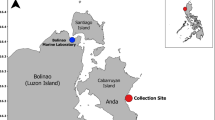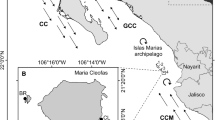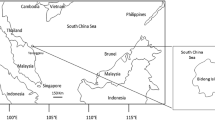Abstract
In this study, we examined the variability and potential patterns of fecundity in the precious Mediterranean red coral Corallium rubrum (L. 1758). A total of 12 populations were selected from the NW Mediterranean Sea. We used a hierarchical sampling design to explore fecundity patterns associated with different environmental conditions found in different cave zones (entrance vs. interior), depths (15–22 vs. 39–42 m), and geographic locations (Côte Bleue vs. Calanques). Overall, 240 apical tips from colonies (10 male + 10 female colonies per population) were analyzed. Fecundity ranged between 1.0 ± 0.7 and 3.2 ± 2.3 mature gonads per polyp in female colonies and between 2.5 ± 1.6 and 6.9 ± 2.5 mature gonads per polyp in male colonies. The fecundity of red coral varied significantly for populations dwelling in different cave zones and geographic areas but not for the examined depths. Our results contribute to the knowledge of red coral fecundity in populations not yet studied in the NW Mediterranean and elucidate significant variability in fecundity within different environmental conditions. The information on coral fecundity can contribute to the development of management and conservation plans for red coral populations.





Similar content being viewed by others
References
Baird AH, Marshall PA (2002) Mortality, growth and reproduction in scleractinian corals following bleaching on the Great Barrier Reef. Mar Ecol Prog Ser 237:133–141
Ballesteros E (2006) Mediterranean coralligenous assemblages: a synthesis of present knowledge. Ocean Mar Biol 44:123–195
Ballesteros E, Zabala M (1993) El bentos: el marc físic. In: Alcover JA, Ballesteros E, Fornós JJ (eds) Història Natural de l’Arxipèlag de Cabrera. CSIC-Moll, Palma de Mallorca, pp 663–685
Beiring EA, Lasker HR (2000) Egg production by colonies of a gorgonian coral. Mar Ecol Prog Ser 196:169–177
Ben-David-Zaslow R, Henning G, Hofmann DK, Benayahu Y (1999) Reproduction in the Red Sea coral Heteroxenia fuscescens: seasonality and long-term record (1991 to 1997). Mar Biol 133:553–559
Bensoussan N, Romano JC, Harmelin JG, Garrabou J (2010) High resolution characterization of northwest Mediterranean coastal waters thermal regimes: to better understand responses of benthic communities to climate change. Estuar Coast Mar Sci 87:431–441
Bramanti L, Magagnini G, De Maio L, Santangelo G (2005) Recruitment, early survival and growth of the Mediterranean red coral Corallium rubrum (L 1758), a 4–year study. J Exp Mar Biol Ecol 314:69–78
Bramanti L, Rossi S, Tsounis G, Gili JM, Santangelo G (2007) Settlement and early survival of red coral aon artificial substrate in different geographic areas: some clues for demography and restoration. Hydrobiologia 580:219–224
Brazeau DA, Lasker HR (1989) The reproductive cycle and spawning in a Caribbean gorgonian. Biol Bull 176:1–7
Brazeau DA, Lasker HR (1990) Sexual reproduction and external brooding by the Caribbean gorgonian Briareum asbestinum. Mar Biol 104:465–474
Castelbon C (1972) Etude de la circulation des masses d’eau dans le golfe de Marseille. Téthys 4:269–312
Chintiroglou H, Dounas C, Koukouras A (1989) The presence of Corallium rubrum (Linnaeus, 1758) in the eastern Mediterranean Sea. Mitt Zool Mus Berlin 65:145–149
Coma R, Ribes M, Zabala M, Gili JM (1995a) Reproduction and cycle of gonadal development in the Mediterranean gorgonian Paramuricea clavata. Mar Ecol Prog Ser 117:173–183
Coma R, Zabala M, Gili JM (1995b) Sexual reproductive effort in the Mediterranean gorgonian Paramuricea clavata. Mar Ecol Prog Ser 117:185–192
Connell JH, Hughes TP, Wallace CC (1997) A 30–year study of coral abundance, recruitment and disturbance, at several scales in space and time. Ecol Monogr 67:461–488
Costantini F, Taviani M, Remia A, Pintus E, Schembri PJ, Abbiati M (2010) Deep-water Corallium rubrum (L.,1758) from the Mediterranean Sea: preliminary genetic characterisation. Mar Ecol 31:261–269
Dayton PK, Robilliard GA, Paine RT, Dayton LB (1974) Biological accommodation in the benthic community at McMurdo sound, Antarctica. Ecol Monogr 44:105–128
Fautin DG (2002) Reproduction of Cnidaria. Can J Zool 80:1735–1754
Fichez R (1991) Suspended particulate organic matter in a Mediterranean submarine cave. Mar Biol 108:167–174
Garrabou J (1997) Structure and Dynamics of North–western Mediterranean rocky benthic communities along a depth gradient: a geographical Information System (GIS) approach. PhD, Universitat de Barcelona
Garrabou J, Flos J (1995) A simple diffusion–sedimentation model to explain planktonic gradients within a NW Mediterranean submarine cave. Mar Ecol Prog Ser 123:273–280
Garrabou J, Harmelin JG (2002) A 20–year study on life history traits of a harvested long–lived temperate coral in the NW Mediterranean: insights into conservation and management needs. J Anim Ecol 71:966–978
Garrabou J, Coma R, Bally M, Bensoussan N, Chevaldonné P, Cigliano M, Diaz D, Harmelin JG, Gambi MC, Kersting DK, Lejeusne C, Linares C, Marschal C, Pérez T, Ribes M, Romano JC, Serrano E, Teixido N, Torrents O, Zabala M, Zuberer F, Cerrano C (2009) Mass mortality in northwestern Mediterranean rocky benthic communities: effects of the 2003 heat wave. Glob Chang Biol 15:1090–1103
Gili JM, Riera T, Zabala M (1986) Physical and biological gradients in a submarine cave on the Western Mediterranean coast (north–east Spain). Mar Biol 90:291–297
Glassom D, Zakai D, Chadwick–Furman NE (2004) Coral recruitment: a spatio–temporal analysis along the coastline of Eilat, northern Red Sea. Mar Biol 144:641–651
Glynn PW, D’Croz L (1990) Experimental evidence for high temperature stress as the cause of El Niño–coincident coral mortality. Coral Reefs 8:181–191
Grigg RW (1977) Population dynamics of two gorgonians corals. Ecology 58:278–290
Hall VR, Hughes TP (1996) Reproductive strategies of modular organisms: comparative studies of reef–building corals. Ecology 77:950–963
Harmelin JG, Vacelet J, Vasseur P (1985) Les grottes sous–marines obscures : un milieu extrême et un remarquable biotope refuge. Téthys 11:214–229
Hughes TP (1994) Catastrophes, phase shifts, and large-scale degradation of a Caribbean coral reef. Science 265:1547–1551
Hughes TP, Jackson JBC (1985) Population dynamics and life histories of foliaceous corals. Ecol Monogr 55:141–166
Hughes TP, Ayre DJ, Connell JH (1992) Evolutionary ecology of corals. Trends Ecol Evol 7:292–295
Hughes TP, Baird AH, Dinsdale EA, Moltschaniwskyj NA, Pratchett MS, Tanner JE, Willis BL (2000) Supply–side ecology works both ways: the link between benthic adults, fecundity and larval recruits. Ecology 81:2241–2249
Hughes TP, Baird AH, Bellwood DR, Card M, Connolly SR, Folke C, Grosberg R, Hoegh–Guldberg O, Jackson JBC, Kleypas J, Lough JM, Marshall P, Nyström M, Palumbi SR, Pandolfi JM, Rosen B, Roughgarden J (2003) Climate change, human impacts, and the resilience of coral reefs. Science 301:929–933
Jokiel PL, Coles SL (1990) Response of Hawaiian and other Indo–Pacific reef corals to elevated temperature. Coral Reefs 8:155–162
Kapela W, Lasker HR (1999) Size–dependent reproduction in the Caribbean gorgonian Pseudoplexaura porosa. Mar Biol 135:107–114
Kojis BL, Quinn NJ (1984) Seasonal and depth variation in fecundity of Acropora palifera at two reefs in Papua New Guinea. Coral Reefs 3:165–172
Laborel J, Vacelet J (1960) Répartition bionomique du Corallium rubrum Lmck dans les grottes et falaises sous–marines. Rapp PV Réun CIESM 16:465–469
Lacaze–Duthiers H (1864) Histoire naturelle du corail. Vol. JB Bailière et Fils, Paris
Lasker HR, Kim K, Coffroth MA (1998) Production, settlement, and survival of plexaurid gorgonian recruits. Mar Ecol Prog Ser 162:111–123
Ledoux JB, Mokhtar-Jamai K, Roby C, Feral J, Garrabou J, Aurelle D (2010) Genetic survey of shallow populations of the Mediterranean red coral (Corallium rubrum (Linnaeus, 1758)): new insights into evolutionary processes shaping current nuclear diversity and implications for conservation. Mol Ecol 9:675–690
Linares C, Coma R, Zabala M (2008) Effects of a mass mortality event on gorgonian reproduction. Coral Reefs 27:27–34
Linares C, Bianchimani O, Torrents O, Marschal C, Drap P, Garrabou J (2010) Marine protected areas and the conservation of long-lived marine invertebrates: the mediterranean red coral. Mar Ecol Prog Ser 402:69–79
Margalef R (1985) Western Mediterranean. Pergamon Press, New York
Marschal C, Garrabou J, Harmelin JG, Pichon M (2004) A new method for measuring growth and age in the precious red coral Corallium rubrum (L.). Coral Reefs 23:423–432
Martin E (1982) Ciclo reproductivo, proporción sexual y fecundidad del coral blando Plexaura homomalla (Esper.) en el Mar Caribe Mexicano (Octocoralla: Plexauridae). An Inst Cienc Mar Limnol Univ Nac Autón México 9:359–380
Michalek-Wagner K, Willis BL (2001) Impacts of bleaching on the soft coral Lobophytum compactum. 1. Fecundity, fertilization and offspring viability. Coral Reefs 19:231–239
Millot C (1979) Wind induced upwellings in the Gulf of Lion. Oceanol Acta 2:261–274
Millot C (1999) Circulation in the Western Mediterranean sea. J Mar Syst 20:423–442
Millot C, Wald L (1980) The effect of the Mistral wind on the Ligurian current near Provence. Oceanol Acta 3:399–402
Pradal M-A (2006) Modélisation hydrodynamique de la baie de Marseille application au projet d’immersion de récifs artificiels en baie du Prado : “récifs Prado 2006”. Ph D Thesis, Université de la Méditerranée (Aix-Marseille II)
Ribes M, Coma R, Rossi S, Michelli M (2007) The cycle of gonadal development of Eunicella singularis (Cnidaria: Octocorallia). Invertebr Biol 126(4):307–317
Rossi S, Tsounis G (2007) Temporal and spatial variation in protein, carbohydrate, and lipid levels in Corallium rubrum (Anthozoa, Octocorallia). Mar Biol 152:429–439
Santangelo G, Carletti E, Maggi E, Bramanti L (2003) Reproduction and population sexual structure of the overexploited Mediterranean red coral Corallium rubrum. Mar Ecol Prog Ser 248:99–108
Sebens KP (1983) The larval and juvenile ecology of temperate octocoral Alcyonium siderium Verrill.II. Fecundity, survival and juvenile growth. J Exp Mar Biol Ecol 72:263–285
Sebens KP (1987) The Ecology of indeterminate growth in animals. Annu Rev Ecol Syst 18:371–407
Sebens KP (1991) Habitat structure and community dynamics in marine benthic systems. In: Bell SS, McCoy ED, Mushinsky HR (eds) Habitat structure. Chapman and Hall, London, pp 211–234
Sebens KP, Witting J, Helmuth B (1997) Effects of water flow and branch spacing on particle capture by the reef coral Madracis mirabilis (Duchassaing and Michelotti). J Exp Mar Biol Ecol 211:1–28
Sebens KP, Helmuth B, Carrington E, Agius B (2003) Effects of water flow on growth and energetics of the scleractinian coral Agaricia tenuifolia, in Belize. Coral Reefs 22:35–47
Stearns SC (1992) The evolution of life histories. Oxford University Press, New York
Szmant AM, Gassman NJ (1990) The effects of prolonged “bleaching” on the tissue biomass and reproduction of the reef coral Montastraea annularis. Coral Reefs 8:217–224
Theodor J (1967) Contribution a l’étude des Gorgones (VII): Ecologie et comportement de la planula. Vie Milieu 18
Torrents O (2007) Biologie des populations du corail rouge Corallium rurum (L. 1758) de Méditerrané nord-occidentale. PhD thesis, Université de la Méditerranée
Torrents O, Garrabou J, Marschal C, Harmelin JG (2005) Age and size at first reproduction in the commercially exploited red coral Corallium rubrum (L.) (Octocorallia, Gorgonacea) in the Marseilles area (France, NW Mediterranean). Biol Conserv 121:391–397
Torrents O, Tambuté E, Caminiti N, Garrabou J (2008) Upper thermal thresholds of shallow vs. deep populations of the precious Mediterranean red coral Corallium rubrum: assessing the potential effects of warming in the NW Mediterranean. J Exp Mar Biol Ecol 357:7–19
Tsounis G, Rossi S, Aranguren M, Gili JM, Arntz W (2006a) Effects of spatial variability and colony size on the reproductive output and gonadal development cycle of the Mediterranean red coral (Corallium rubrum L.). Mar Biol 148:513–527
Tsounis G, Rossi S, Lauden J, Bramanti L, Fernández N, Gili JM, Arntz W (2006b) Diet and seasonal prey capture rates in the Mediterranean red coral (Corallium rubrum L.). Mar Biol 149:313–325
Tsounis G, Rossi S, Gili JM, Arntz W (2007) Red coral fishery at the Costa Brava (NW Mediterranean): case study of an overharvested precious coral. Ecosystems 10:975–986
Underwood AJ (1997) Experiments in ecology. Cambridge University Press, Cambridge
Vighi M (1970) Richerche sul ciclo reproduttivo del corallo rosso [Corallium rubrum (L.)] del promotorio di Portofino. Atti Acc Naz Lincei Mem, S VIII, vol X, sez 3 10:1–26
Vighi M (1972) Etude sur la reproduction du Corallium rubrum (L.). Vie Milieu 23:21–32
Weinberg S (1979a) Autoecology of Shallow–water Octocorallia from Mediterranean rocky substrata. I: the Banyuls area. Bijd Dierkd 49:1–15
Weinberg S (1979b) The light–dependent behaviour of planula larvae of Eunicella singularis and Corallium rubrum and its implication for octocorallian ecology. Bijd Dierkd 49:16–30
Acknowledgments
The authors gratefully acknowledge the helpful assistance during sampling of R. Graille, F. Zuberer, B. de Ligondes, T. Perez, P. Chevaldonné, W. Tillez, F. Bachet, and other staff of “Parc Marin de la Côte Bleue”. Comments, suggestions, and fruitful discussions with D. Allemand, J. Vacelet, J. G. Harmelin, M. Zabala, and F. Bachet vastly improved the manuscript. This study was funded by the “Provence–Alpes–Côte d’Azur” region (O.T. Doctoral Fellowship) and partly by the IFB (Institut Français de la Biodiversité) and the Environmental Department of TOTAL–Fina–Elf group and French Ministerial ACI program “Jeunes chercheurs 2003” (Changement climatique: possible conséquences pour la conservation d’espèces longevives dans les habitats littoraux méditerranéens).
Author information
Authors and Affiliations
Corresponding author
Additional information
Communicated by T. L. Goulet.
Rights and permissions
About this article
Cite this article
Torrents, O., Garrabou, J. Fecundity of red coral Corallium rubrum (L.) populations inhabiting in contrasting environmental conditions in the NW Mediterranean. Mar Biol 158, 1019–1028 (2011). https://doi.org/10.1007/s00227-011-1627-5
Received:
Accepted:
Published:
Issue Date:
DOI: https://doi.org/10.1007/s00227-011-1627-5




